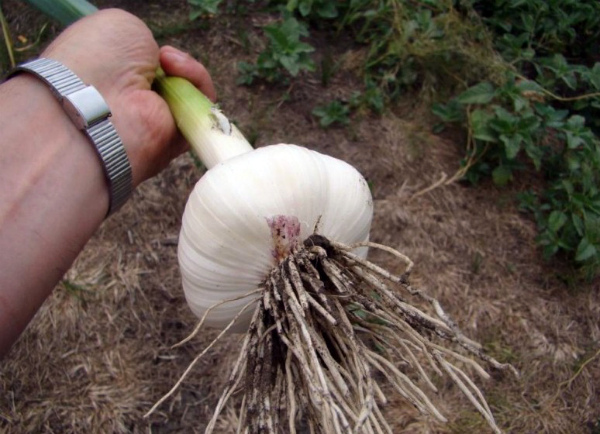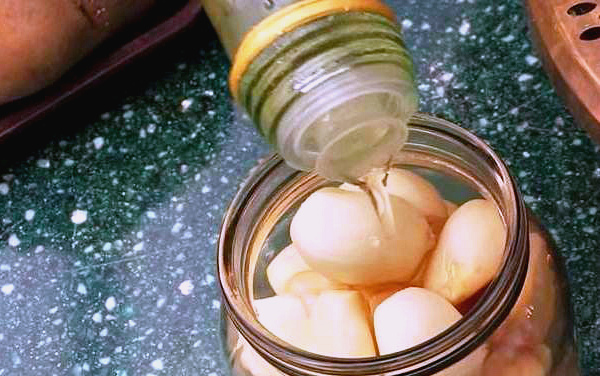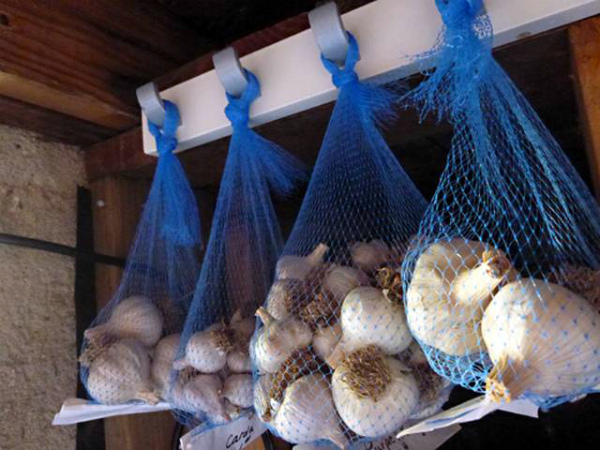Rules for storing garlic at home in winter
Content
Harvesting garlic
As soon as winter or spring garlic ripens, that is, its leaves turn yellow, the false stem will become soft and sink to the ground, and the husk will easily move away from the cloves - you need to quickly remove it from the garden so as not to spoil further storage, and it itself does not dry out. Winter is best harvested in July, spring - in August or early September.
Use a pitchfork or a shovel to gently pry the bulbs out of the ground, being careful not to damage either the bulb itself or the roots of the plant. If the weather is cloudy but not rainy, place the fruits in the beds. If it is raining or very hot, move the bulbs under a canopy. Harvesting does not end there: very carefully, trying not to break the roots, clean the bulbs from the soil. You can rinse them in cool water and then leave to dry. This will allow you to prepare the bulbs for storage. You need to keep your harvest under a canopy for about 10 days so that all vegetative processes naturally stop.
An important condition in order to properly prepare garlic heads is to maintain low air humidity. Thus, when the harvest is over, you will have juicy fruits that are not spoiled by moisture and rot, which can be stored without problems at home until spring.
Bulbs are best harvested in dry weather, in the early morning or late evening, to avoid scalding from the scorching sun. Both spring and winter species do not tolerate overexposure in the ground and high temperatures, so try to do everything right, then it will be much easier to save the harvest.
After the drying stage, we remove the excess parts - we cut the roots and stems. Now you can consider storage methods that will help preserve the fragrant bulbs until spring.
Storage methods
There are several ways to save garlic at home in winter so that it does not spoil. The first thing that comes to mind is the old, so to speak, grandmother's method - to weave spring garlic into beautiful braids, which delight the eye with their appearance until spring. But this is not the only and far from the most reliable storage method.
Wooden box
Storing the bulbs in a wooden box is one of the most convenient ways. You will need a roomy drawer with holes in the sides. At its bottom, you need to pour a centimeter layer of salt, wood ash or sawdust. Then the bulbs and a new intermediate layer are laid. Repeat these two steps until the drawer is full. So that spring garlic retains all its beneficial properties, we remove the box in a dry, cool place.
Oil
Oil storage is a great way when you have nowhere to put a bulky drawer, but you want fresh cloves in winter. To do this, the bulbs must be peeled, and then the cloves must be folded into a jar. Try to stack them tightly, you can even shake the jar a couple of times. You can use any oil - sunflower, olive, corn, in general, whatever you like. Pour the oil into the jar so that it completely covers the cloves.After that, close the jar with a lid with holes, remove it in the refrigerator and enjoy the result for the next 3-4 months. A big plus of this storage method is that you get not only fresh garlic, but also aromatic oil.
Pouches
A convenient way of storage is paper or cloth bags. Mix the heads with the onion skins, put them in bags, and then hang them in a dry place. Spring garlic is best stored when the temperature is around + 5-7 ° C. However, for a large number of bulbs, this option will not work, unless you have a spacious cellar, since the bags should be hung for better ventilation and long-term preservation.
Paraffin
A somewhat exotic, but, nevertheless, effective way is to dip spring bulbs in paraffin. Melt the paraffin wax, but observe all safety rules. Holding the stem by the onion, dip it into the hot mixture. When it is completely covered with paraffin, hang it up to freeze the mass. You need to remove such garlic in a dark, cool place, where it will save moisture and useful properties until spring.
Prevention of spoilage
When spring garlic has gone to wait in the wings, it is important not to let it go bad. The slightest violation of the conditions, and now it has already begun to rot, covered with mold or eaten by insects. It so happens that you did not finish and sent garlic heads infected with nematodes or fungus for processing, then it will no longer be possible to save them.
Store the garlic in a dark, dry, cool place, otherwise it will go bad and you will lose not only the ingredients used for processing, but also the bulbs themselves.
Provide adequate ventilation in the area where your crop is stored. Treat the cellar with fungicides and insecticides, and then ventilate well so that no pest can take root there. When storing garlic in the refrigerator, manually adjust the temperature and humidity.
Video "A proven way to store garlic"
Check out the tried and tested way to store garlic heads at home, in which they are stored all winter, and in the spring they seem to have just been dug out of the garden.




